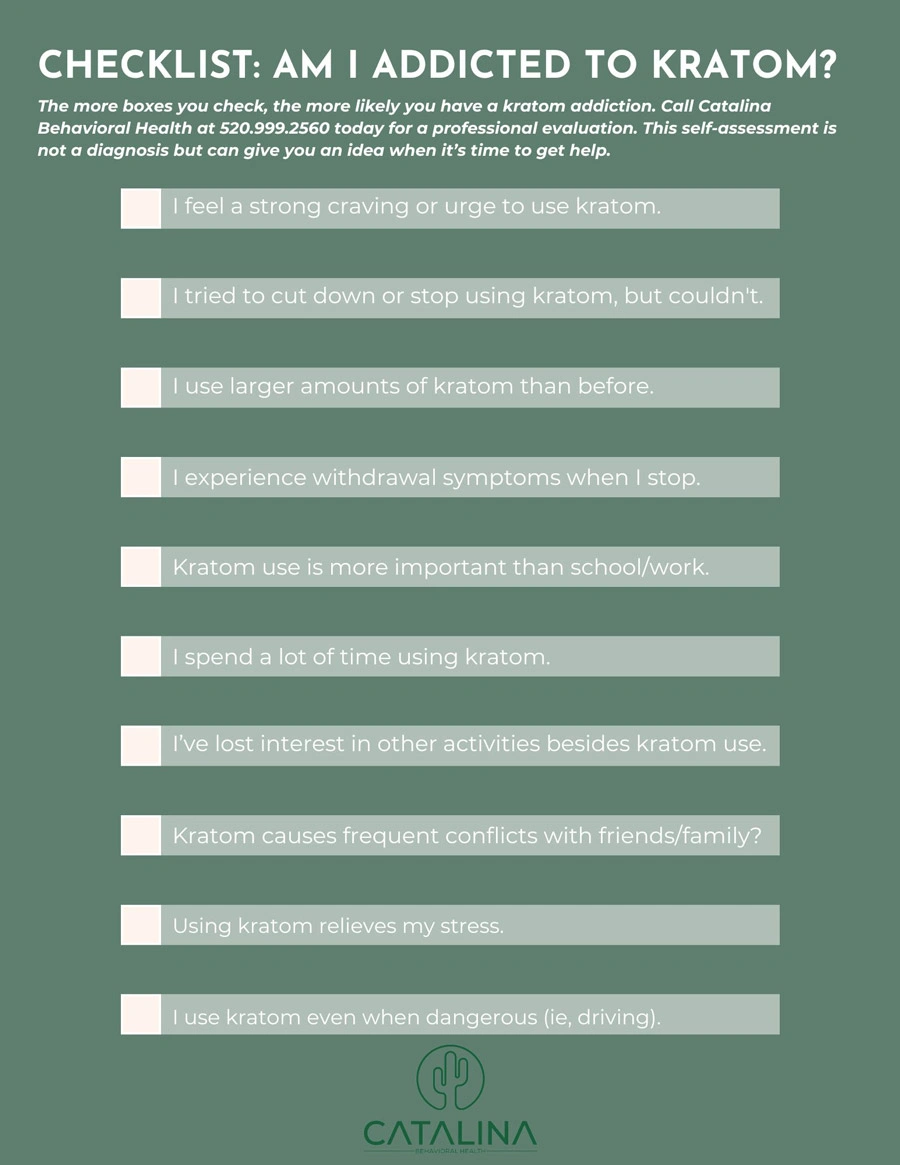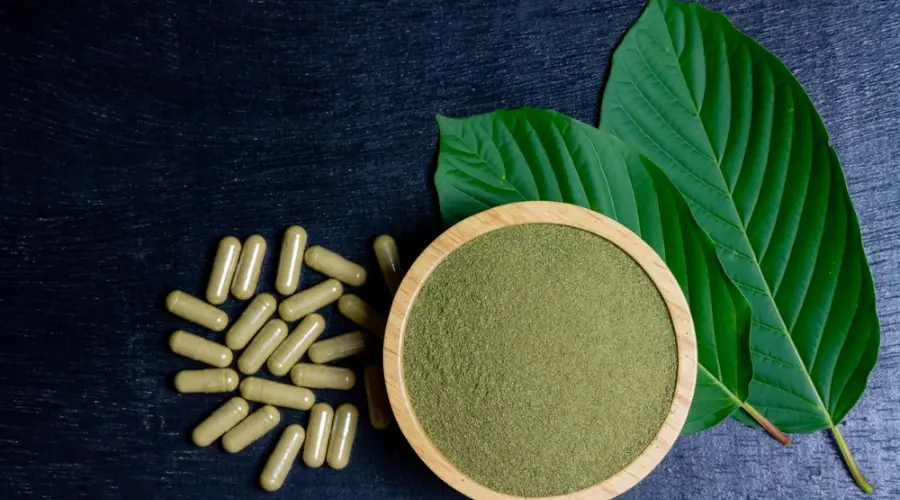Get Answers and Support on Kratom Withdrawal Symptoms
Those who use kratom often start innocently enough. It’s classified as a dietary supplement and, therefore, widely available in retail locations, from gas stations to smoke shops and many other locations.
But just because it’s not a controlled substance, it doesn’t mean that it cannot lead to drug abuse.
Many clients struggling to quit often ask about the kratom withdrawal timeline, wondering how long the most severe symptoms might last.
Catalina Behavioral Health in Tucson, Arizona, provides evidence-based therapies for mental disorders and drug and alcohol dependence, which often occur at the same time.
We treat the underlying psychological symptoms to ensure every client has the best chance of a full recovery and enjoys long-term sobriety.
We invite you to read more to learn how – and when – kratom withdrawal occurs and why it can be just as dangerous as an opioid addiction.
Get Effective Detox and Rehab Options at Catalina
How Long Does Kratom Withdrawal Last?
The first step of ending kratom addiction is shedding the substance from your body. But for how long will you experience the acute withdrawal symptoms of kratom? Predicting the length of the time can be a little tricky.
The Kratom Withdrawal Timeline Varies
Several factors may influence how long you will feel poorly after ending kratom use. Here are a few things that determine how long the kratom withdrawal process might last:
Kratom Dosage and Usage Habits
Those who use higher doses of kratom or who use more usually have higher kratom dependence. Higher doses and using it often can point to more severe kratom withdrawal symptoms, perhaps for a longer time.
Those who use low doses and at lesser frequencies may have a bit of an easier time quitting kratom. Those who mix substances, such as kratom and alcohol, or kratom and benzodiazepines, will typically endure a more difficult and prolonged withdrawal period.
Metabolism Variances Impact Kratom Detox
Some people have a naturally faster metabolism and will process and eliminate kratom faster than others. Factors determining metabolic rates include age, weight, other substances in the system, or illnesses.
Hydration and Nutrition Habits
Kratom users who don’t look after their nutrition or drink enough water may inadvertently slow down their body’s ability to recover.
Other Mental Health Concerns
Those who experience other mental health concerns may experience heightened anxiety or intense psychological symptoms of kratom withdrawal. When these are present, it can prolong the kratom withdrawal timeline and make things a little more complicated.
An Approximate Timeline for Kratom Withdrawal Symptoms to Last

Let’s get back to the original query: How long does kratom withdrawal last?
Considering the possible variables we’ve discussed, here’s a general look at how long the opioid-like effects can last in kratom-dependent users:
6 to 12 Hours After the Last Dose
The first withdrawal symptoms usually appear between 6 and 12 hours after last abusing kratom or similar addictive substances. These symptoms continue for a day or more.
Here are the early physical and psychological symptoms of kratom withdrawal:
- Anxiety
- Runny nose
- Loss of appetite
- Restlessness
- Mood swings
- Kratom cravings begin
This phase can last for a day or more.
1 to 3 Days After Using Kratom (Withdrawal Symptoms Peak)
Kratom withdrawal is similar to opioid withdrawal symptoms. During the first several days, you might experience flu-like symptoms, including:
- Muscle aches
- Runny nose may continue
- Nausea or abdominal pain
- Vomiting
- Diarrhea
- Sleep disturbances
- Cravings for kratom continue
- Mood swings
- Heightened anxiety
- Psychotic symptoms (in rare circumstances!)
These withdrawal symptoms will start to diminish around day 4 after the last use.
4 to 7 Days (Significant Reduction in Kratom Withdrawal Symptoms)
In a week or less, the most severe withdrawal symptoms will decrease significantly. The physical symptoms, such as nausea or muscle aches, will lessen. You have greater medical stability and will start to feel much better, at least physically.
However, the mental symptoms associated with kratom may persist. Remember that substance use disorder encompasses kratom abuse and is listed as a mental health diagnosis in the Diagnostic and Statistical Manual (DSM).
With the help of treatment providers and receiving counseling and behavioral therapies, you will start to recover your mental health in the coming days.
7 to 14 Days (Start Having Kratom Addiction Treated by a Professional)
You might experience lingering symptoms, but things are much improved after about a week.
After the first few days of kratom detox treatment, you will be ready to start counseling. Catalina therapists customize programs to help clients as soon as the kratom withdrawal symptoms allow them to participate, sometimes sooner than 7 days.
With the therapist’s help, you will discover why your kratom addiction started and use evidence-based therapies to address it. Our team often recommends clients try Motivational Interviewing (MI), Cognitive Behavioral Therapy (CBT), or other science-backed treatments while transitioning into the next phase of treatment.
Is Kratom Withdrawal Dangerous? You Need a Kratom Detox Facility

It’s extremely hard to quit kratom, and going cold turkey is not the answer. Trying kratom at home can cause a host of psychological and mental health issues, including:
- Dehydration and nutrient deficiencies
- Increased risk of relapse
- Seizures (uncommon)
- Rarely, organ damage, including heart, liver, or kidney injury
These come from sudden cessation after developing a physical dependence on Kratom.
Instead, you should seek a professional detox treatment center, such as the medical detox program we offer here at Catalina. You will have a safe and supportive environment as you go through the kratom withdrawal symptoms.
Our staff provides medical supervision. We’ll closely monitor your well-being, both physically and mentally. Our doctor can prescribe FDA-approved medications for managing withdrawal symptoms associated with kratom.
Once those withdrawal symptoms are under better control, you can focus on healing from your addiction.
Get Licensed Drug Addiction Treatment at Catalina
Carla Learned About the Dangers of Kratom Withdrawal
‘Carla,’ a successful accountant, started to use kratom after hearing it could help ease the pain of her frequent headaches, which she had dealt with for most of her adult life. She first saw it on a shiny rack at a gas station, where she’d popped in to buy a packet of headache powder. Being labeled as, “all natural,” she thought she had made a healthy choice.
The kratom did a great job helping Carla manage her headaches. But a few weeks after using it, she found she needed to use more of it to get the same pain relief. Over time, she began taking it more frequently, as well, with the headaches returning rapidly after the last dose.
During her annual physical, Carla mentioned the kratom use to her family doctor. The physician mentioned her concern to Carla and advised her to stop using it and suggested she see a neurologist about the headaches.
The neurology reports revealed no neurological causes for the headaches. Still, Carla tried to stop the kratom use. But stopping made her vomit so much that she became dehydrated to the point of a stay in the local hospital.
Getting Proven Programs to Put Kratom in Her Past
Carla came to Catalina ready to put the nightmare of pain and addiction behind her. Our clinical staff realized that the clear report from the neurologist suggested a mental health cause of the headaches.
We soon discovered that Carla had repeatedly witnessed domestic violence throughout her childhood; traumatic stress had caused severe tension headaches. She had never considered a connection between her childhood trauma and the headaches and had never mentioned it to a doctor. Nor had they asked.
Once we made this connection, Carla received therapies to help lessen the impact of the past trauma. We also helped her learn stress management techniques to cope healthily in the future. Carla has embraced a balanced, healthier lifestyle and reports that her headaches are now uncommon.
What Is Kratom?

Kratom is a plant native to Southeast Asia, specifically from Thailand, Indonesia, and Malaysia. There, healers have relied on these leaves for centuries for both their stimulant and sedative effects.
Kratom use produces opioid-like effects because it changes the brain chemistry in the same way. It offers the chronic pain relief many seek by binding to the opioid receptors in the brain.
Kratom produces stimulant-like effects in small doses, increasing energy and alertness. But with larger doses, kratom has opioid-like sedative effects, making users sleepy.
Many turn to substance abuse, including kratom, to self-medicate. After an initial use, they start relying on it for its pain-relieving effects, for easing depression, or to manage opioid withdrawal. However, it also carries the risk of Kratom addiction and withdrawal symptoms itself.
The Drug Enforcement Administration Calls Kratom a “Drug of Concern.”
The DEA concedes that kratom is not controlled under the Controlled Substances Act. They also note that the Food and Drug Administration, which approves and regulates medications for use in the United States, has not approved kratom use for any known medical use.
FDA leadership has now listed kratom as a “Drug and Chemical of Concern.”
Healing Kratom Addiction at Catalina Behavioral Health

The staff at Catalina Behavioral Health has helped numerous people manage the kratom withdrawal process and move on to successful healing.
What’s the key to our high success rate?
We customize our programs – for kratom withdrawal or other substances – to suit individual needs. From the first day of medical detox to the last day of treatment, individualized care is our main goal. We consult frequently and stay on top of every person’s progress.
Besides medical detox (which we covered at length earlier), here are some of the ways we can help you recover from kratom or opioid addiction:
Verifying Insurance Coverage
Before you even arrive for your kratom withdrawal, our admissions team will work on your behalf. They will contact your insurer to get any pre-authorizations for care. You’ll have peace of mind knowing that the costs of substance abuse treatment will be minimized.
We work with:
- All leading individual and group health insurance programs
- Some forms of AHCCCS, Arizona Medicaid as well as
- AIHP, the American Indian Health Program.
Would you like our assistance with managing that insurance process? Call us today to verify your insurance coverage.
Full Continuum of Care
Our full continuum of care means that we will support you at every stage of recovery. Whether you come for kratom withdrawal and outpatient treatment or need to address a long-term opioid withdrawal process and inpatient care, we can help.
Besides psychological therapies, you will build coping skills and emotional resilience to help you reduce the risk of relapse after you leave your program. We want you to quit kratom use once and for all!
Up To 100% of Rehab Costs Covered By Insurance
Reach Out to Catalina Behavioral Health to Stop Kratom Use
We are here for you whenever you are ready to start the kratom withdrawal process. You can do this! With our help, you will start feeling better within a week, according to the kratom withdrawal timeline. In fact, you can achieve recovery in a short time.
The work you’ll put in will be challenging at times, but the renewed sense of self-esteem and sobriety will be worth it.
If your mind is made up to start today, we can often accommodate same-day admissions. Call us right away.





